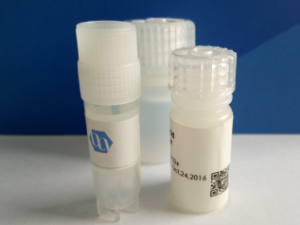$ 1,200.0
Quantity:1mg
In stock
Description
Product name: Androctonin
Catalog#: 1312001
Organism: Sahara scorpion
Synonyms:RSVCRQIKICRRRGGCYYKCTNRPY
Sequence: Arg-Ser-Val-Cys-Arg-Gln-Ile-Lys-Ile-Cys-Arg-Arg-Arg-Gly-Gly-Cys-Tyr-Tyr-Lys-Cys-Thr-Asn-Arg-Pro-Tyr
Modifications: Disulfide(1-4,2-3)
M.W: 3076.64
M.F.: C129H215N43O33S4
Purity: 95%
Counter ion: Trifluoacetate
Format: Lyophilized powder
Description: Androctonin is a 25-residue non-haemolytic anti-microbial peptide isolated from the scorpion Androctonus australis and contains two disulphide bridges. Androctonin is different from known native anti-microbial peptides, being a relatively hydrophilic and non-amphipathic molecule. This raises the possibility that the target of androctonin might not be the bacterial membrane, shown to be a target for most amphipathic lytic peptides. To shed light on its mode of action on bacteria and its non-haemolytic activity, we synthesized androctonin, its fluorescent derivatives and its all-D-amino acid enantiomer. The enantiomer preserved high activity, suggesting a lipid-peptide interaction between androctonin and bacterial membranes. In Gram-positive and (at higher concentrations) Gram-negative bacteria, androctonin induced an immediate perturbation of the permeability properties of the cytoplasmic membrane of the bacterial energetic state, concomitant with perturbation of the morphology of the cell envelope as revealed by electron microscopy. Androctonin binds only to negatively charged lipid vesicles and induces the leakage of markers at high concentrations and with a slow kinetics, in contrast with amphipathic alpha-helical anti-microbial peptides that bind and permeate negatively charged vesicles, and to a smaller extent also zwitterionic ones. This might explain the selective lytic activity of androctonin towards bacteria but not red blood cells. Polarized attenuated total reflection-Fourier transform infrared spectroscopy revealed that androctonin adopts a beta-sheet structure in membranes and did not affect the lipid acyl chain order, which supports a detergent-like effect. The small size of androctonin, its hydrophilic character and its physicochemical properties are favourable features for its potential application as a replacement for commercially available antibiotics to which bacteria have developed resistance.
Uniprot ID: P56684
Usage: For Scientific Research Use Only, Not for Human Use.

